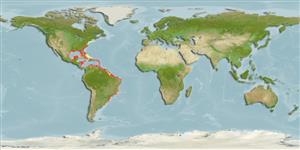Common names from other countries
Environment: milieu / climate zone / depth range / distribution range
Sinh thái học
Biển Cùng sống ở rạn san hô; Mức độ sâu 1 - 80 m (Ref. 5217). Subtropical; 42°N - 35°S, 98°W - 28°W
Western Atlantic: North Carolina, USA, the northern Gulf of Mexico and the Bahamas southward to Uruguay. Occurrence in western Caribbean is doubtful (Ref. 26938).
Length at first maturity / Bộ gần gũi / Khối lượng (Trọng lượng) / Age
Maturity: Lm 12.9 range ? - ? cm
Max length : 30.0 cm TL con đực/không giới tính; (Ref. 7251); common length : 16.0 cm TL con đực/không giới tính; (Ref. 5217)
Các tia vây lưng cứng (tổng cộng) : 10; Các vây lưng mềm (tổng cộng) : 12; Tia cứng vây hậu môn: 3; Tia mềm vây hậu môn: 7 - 8. Body pale brown dorsally with several vertical dark brown bars, becoming white ventrally; dorsal fin dusky with longitudinal yellow lines; pectoral, pelvic and anal fins dusky; caudal fin dusky with small yellow blotches (Ref. 13608). Preopercle has spines radiating from 2 centers (Ref. 26938).
Inhabits bays, coastal grassy areas and shallow banks. Solitary (Ref. 26340) and retreats into shelter when frightened (Ref. 9710). Neither opercular spine nor anterolateral glandular grooves with venom gland is present (Ref. 57406). Synchronously hermaphroditic. Popular as a pan fish despite its small size.
Life cycle and mating behavior
Maturities | Sự tái sinh sản | Spawnings | Egg(s) | Fecundities | Ấu trùng
Simultaenous hermaphrodite. The gonad contains ovarian and testicular tissue separated by a thin basement membrane, with no means of internal self-fertilization.
Robins, C.R. and G.C. Ray, 1986. A field guide to Atlantic coast fishes of North America. Houghton Mifflin Company, Boston, U.S.A. 354 p. (Ref. 7251)
IUCN Red List Status (Ref. 130435)
CITES (Ref. 128078)
Not Evaluated
Human uses
Các nghề cá: Tính thương mại; cá để chơi: đúng
Các công cụ
Special reports
Download XML
Các nguồn internet
Estimates based on models
Preferred temperature (Ref.
115969): 21.9 - 28, mean 25.2 (based on 542 cells).
Phylogenetic diversity index (Ref.
82804): PD
50 = 0.5002 [Uniqueness, from 0.5 = low to 2.0 = high].
Bayesian length-weight: a=0.00912 (0.00746 - 0.01115), b=3.10 (3.06 - 3.14), in cm Total Length, based on LWR estimates for this species (Ref.
93245).
Mức dinh dưỡng (Ref.
69278): 4.5 ±0.0 se; based on diet studies.
Thích nghi nhanh (Ref.
120179): Chiêù cao, thời gian nhân đôi của chủng quần tối thiểu là dưới 15 tháng (K=0.29-1.5; tm=1.01).
Fishing Vulnerability (Ref.
59153): Low vulnerability (15 of 100).
Climate Vulnerability (Ref.
125649): Moderate vulnerability (36 of 100).
